I am originally Tasmanian, so walking through temperate rainforest is my bushwalking spiritual home. T2, on the other hand, is a true Blue Mountains walker, with rocky ridges and high camps among his favourite things. When we had a free day for a walk while in Tassie then, I wanted to pick something that T2 would enjoy, and give him a taste of what my home state has to offer. I was also aiming for one away from the crowds, and ideally somewhere I hadn’t been previously.
Not having any maps with us, we needed to pick something fairly straight forward. I ended up settling on Mount Murchison — a foreboding peak near Tullah, in western Tasmania. Close to Cradle Mountain-Lake St Clair National Park, it provides great views over the iconic high country, but is far enough off the beaten track to be free from the hordes of walkers found elsewhere.
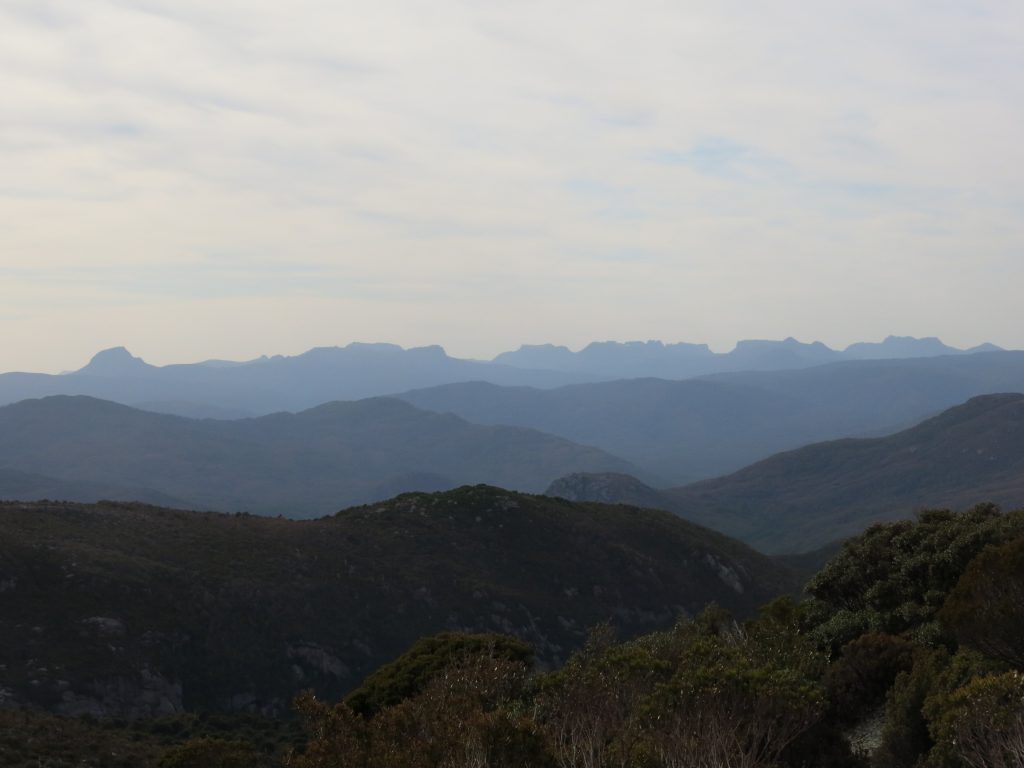
When a chat to a local the night before our walk revealed it was possible to turn our planned walk into a loop via a hidden mountain lake, I knew we were on to a winner. A quick trawl of bushwalking forums and online maps gave us all the information we needed.
Crawling along a winding mountain road, we carefully watched the unique numbers on each passing telegraph pole. Eventually we found pole D55 and parked the car. As promised, the track to Lake Sandra started from the embankment opposite.
We set off up the hill, following the track as it made its way through the usual Tasmanian progression of temperate rainforest, tea tree scrub, and finally low alpine vegetation.

Lower down vegetation was quite thick, with the track taking a circuitous route as it sought out the path of least resistance.
Soon we were atop a knoll, looking across Lake Sandra. We headed down for a quick dip, but despite my best efforts I couldn’t convince T2 that the water temperature was conducive to swimming. I was still keen for a swim, but wading out the water depth remained frustratingly thigh depth. Eventually I gave up on my swim and simply sat down for a refreshing dunk before heading back to shore.
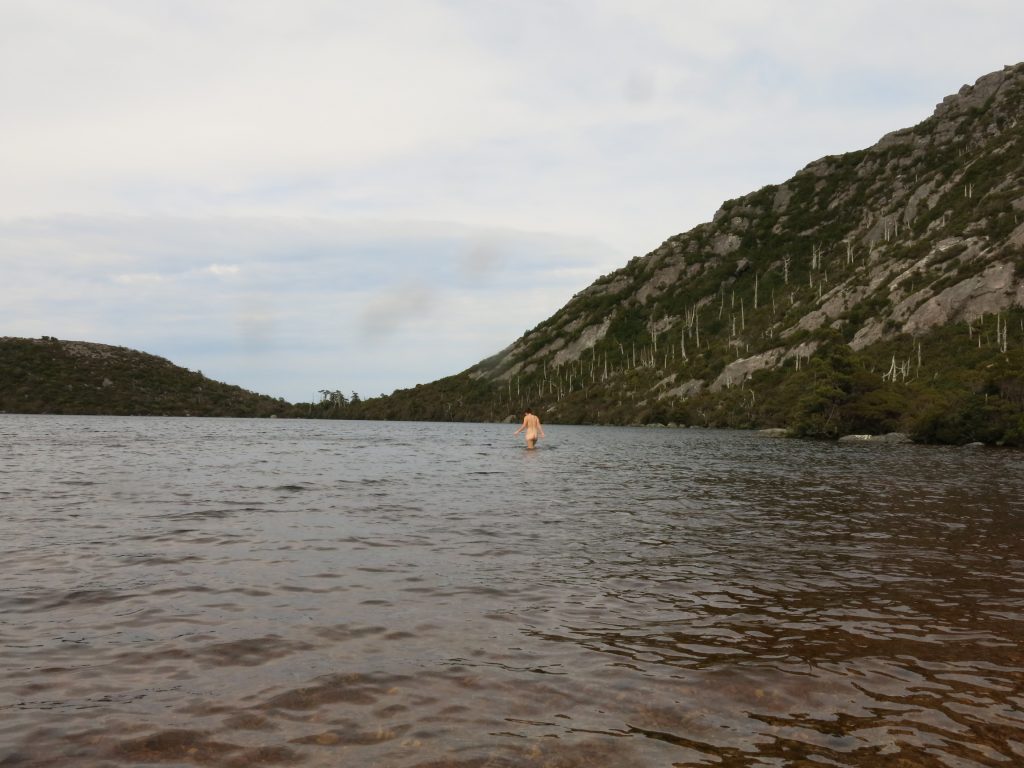
From the lake, we headed up the obvious spur to the ridge. T2 had his first taste of the joy that is bushbashing through scoparia, but it was short-lived and the route up was relatively easy.
Up on top we were met with blustery wind from the west, but that was easily counteracted by the wonderful views over to the plateau and peaks beyond.
From here the ridge contained boulder hopping and stunted trees, leading to low alpine meadow. Each turn brought a new and lovely view, whether to lakes below or peaks beyond.

Being October, we were delighted to find a remnant of snow, and went down to play on it.
As we continued to follow the cirque around to the summit, we chanced across intermittent cairns. They seemed unnecessary given the clear views across the cirque, and we were far too busy enjoying exploring either side to bother restricting ourselves to the cairned route.
As we progressed towards the summit, the ridge became narrower and narrower, with a visible pad forming, before it culminated in a beautiful knife edge with sheer drops on either side.

With the most technical part out of the way, the route became more difficult to follow. We wasted some time following false pads on the tricky terrain, before dropping onto sloping rock slabs and following them back up again towards the trig point.
By this time, low grey clouds were starting to roll in from the west. I let T2 know, but he was blissfully unaware of what this meant, and too enchanted by the walk to worry. I hoped we would get to a track before visibility deteriorated and the inevitable downpour hit.

Thankfully, there was a track from the trig point which initially followed rocky slabs further around the cirque before becoming much easier to follow on the sheltered eastern side. We relaxed, knowing we weren’t going to get lost from here.
The track overlooked more lovely hanging lakes as it progressed steadily down the hill. T2 marvelled at thin sheets of conglomerate, sliced by ancient glaciers.
At one stage, in a gully covered with snow, T2’s patented sliding/skiing technique ended with wet feet as the snow collapsed beneath him, revealing an unseen creek much to my amusement.
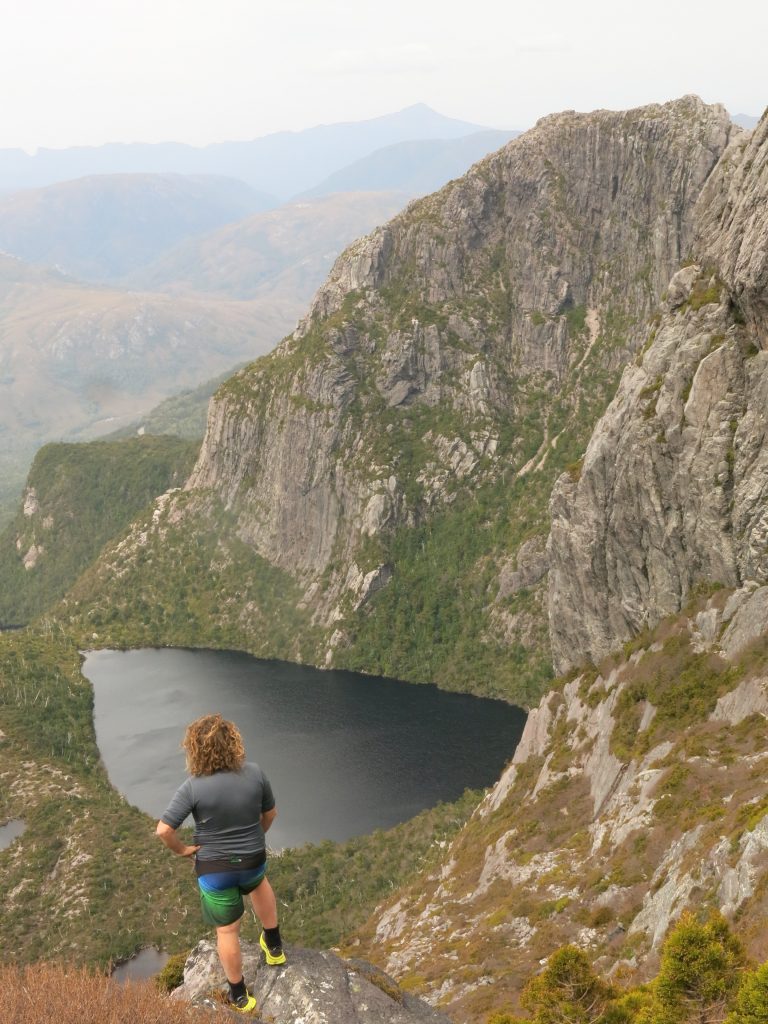
The track continued to drop and the skies became progressively darker. By the time the rain hit we were in thick and sheltered forest, so we didn’t actually notice it until we popped back out onto the road at pole D15, where the traditional route up Mt Murchison begins.
With massive grins on our faces, we started off on the 5km road walk back to our car.
Halfway there we were picked up by a lovely tradie. She didn’t seem to mind that we were soaking wet at this point and happily dropped us back to our starting point — another added bonus to our already fabulous day.

It had been a great taste of Tasmanian walking, complete with lake swims, scrubby sections, temperate rainforest, tea tree, high alpine meadow and rock hopping — completed by the full gamut of Tasmanian weather. The only thing missing was Tassie style mud!
With easy road access and amazing views (in good weather), we were really surprised that this walk is not more popular. It is certainly among my favourite walks in the state.


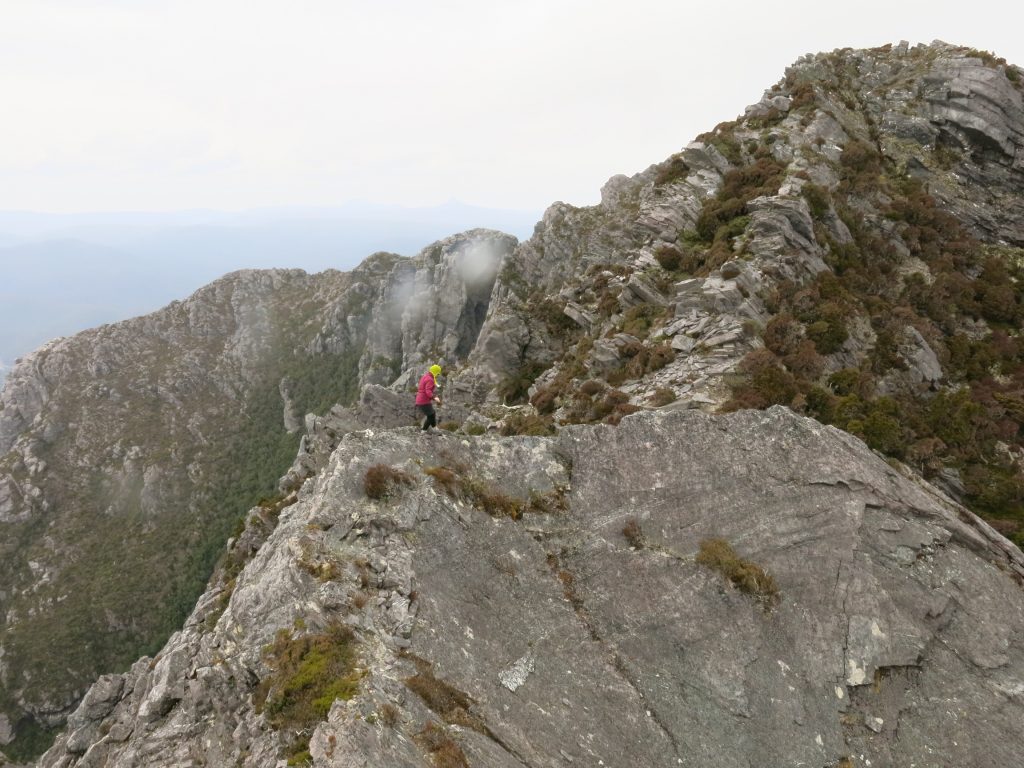



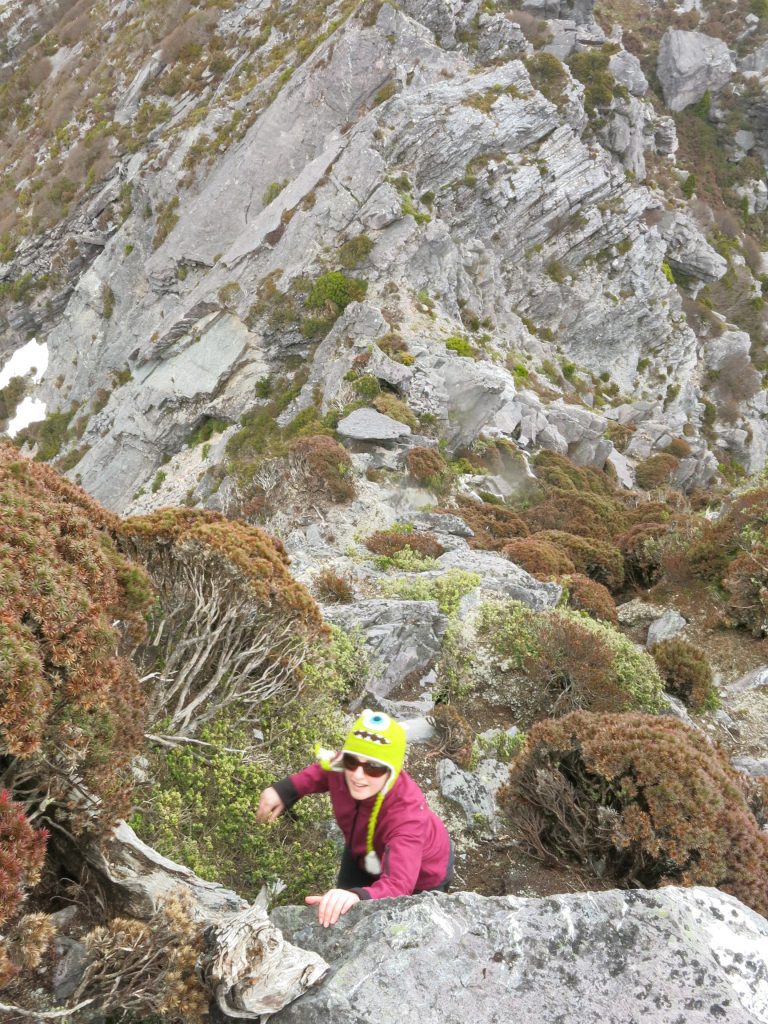

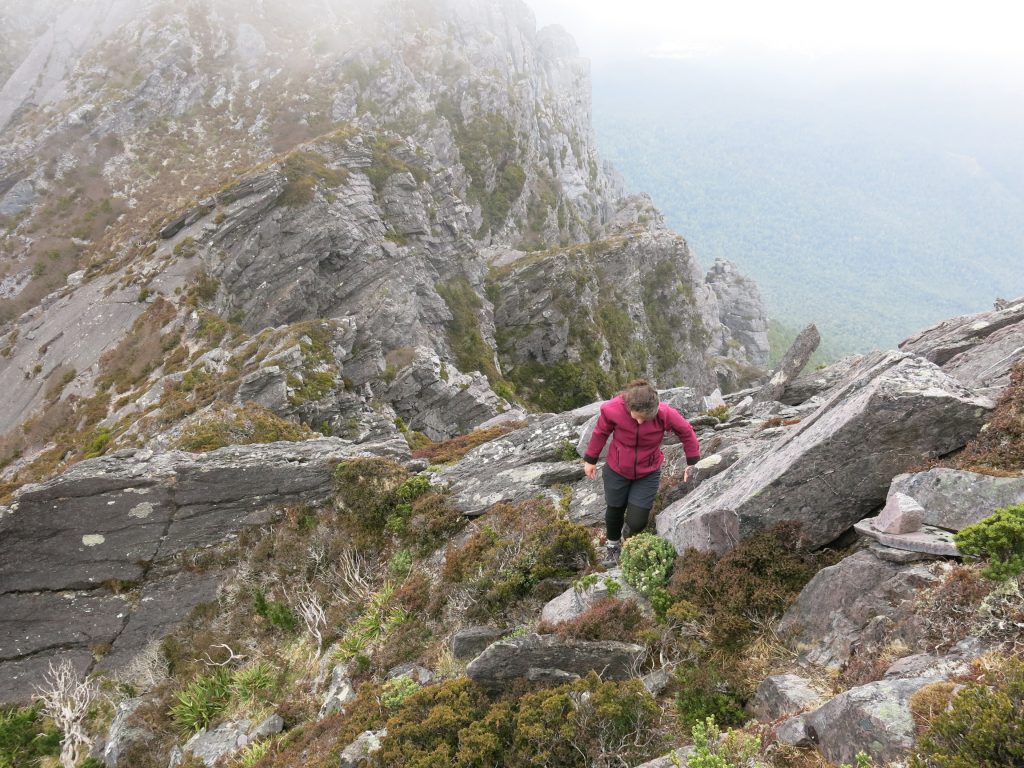
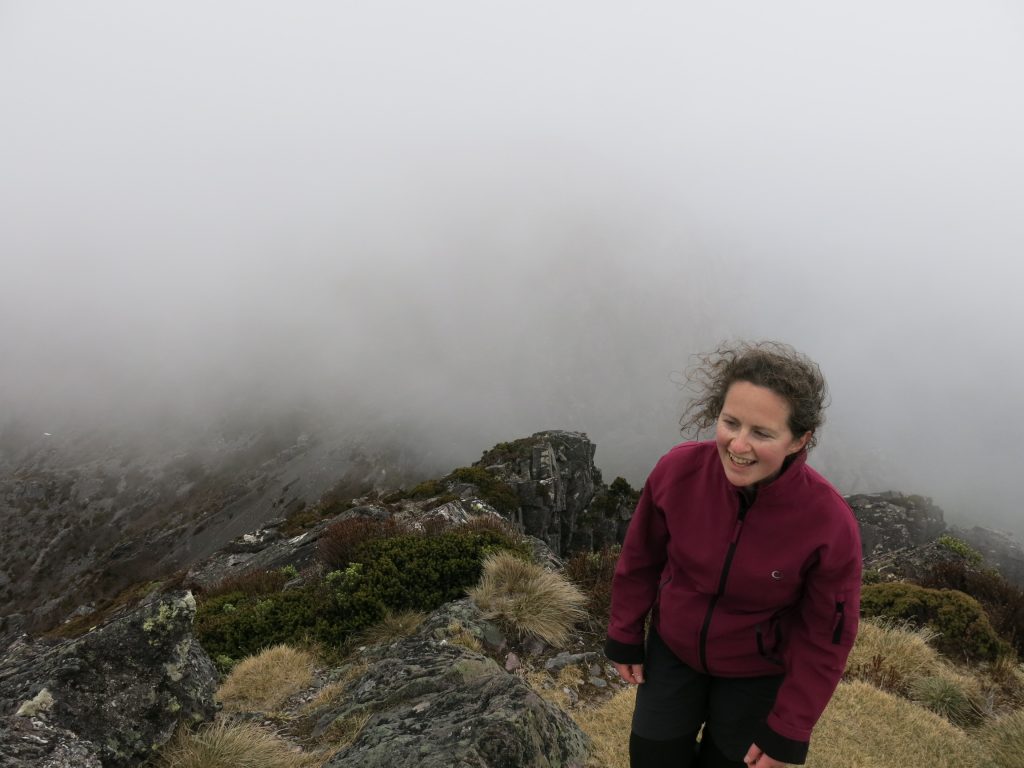
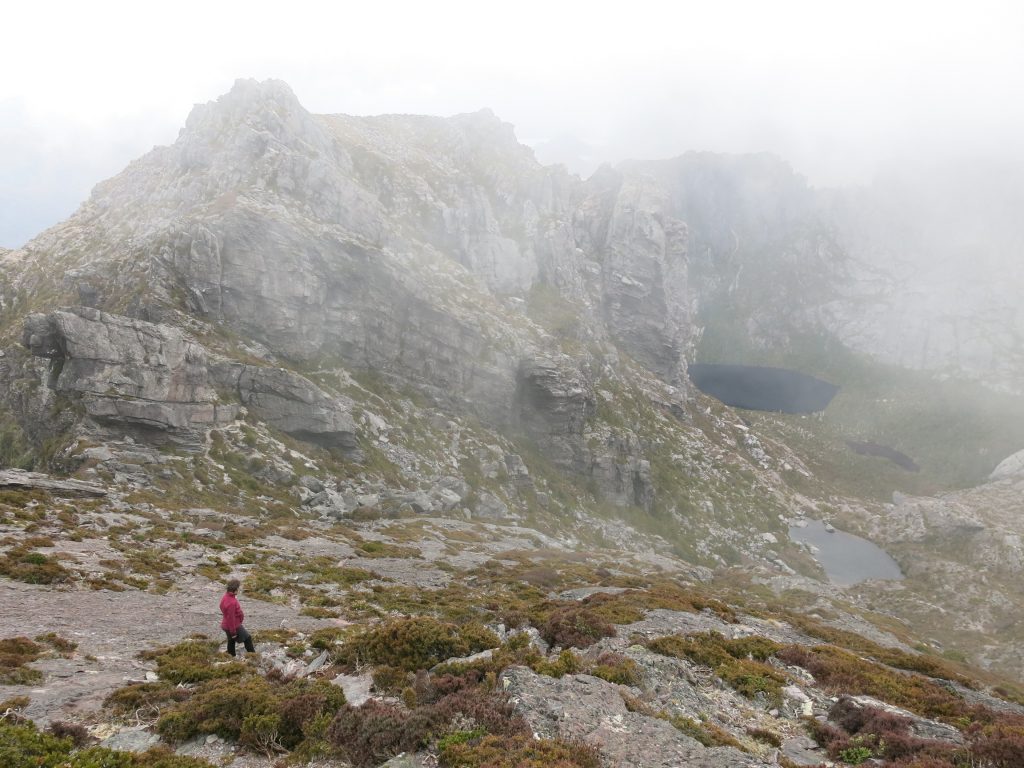

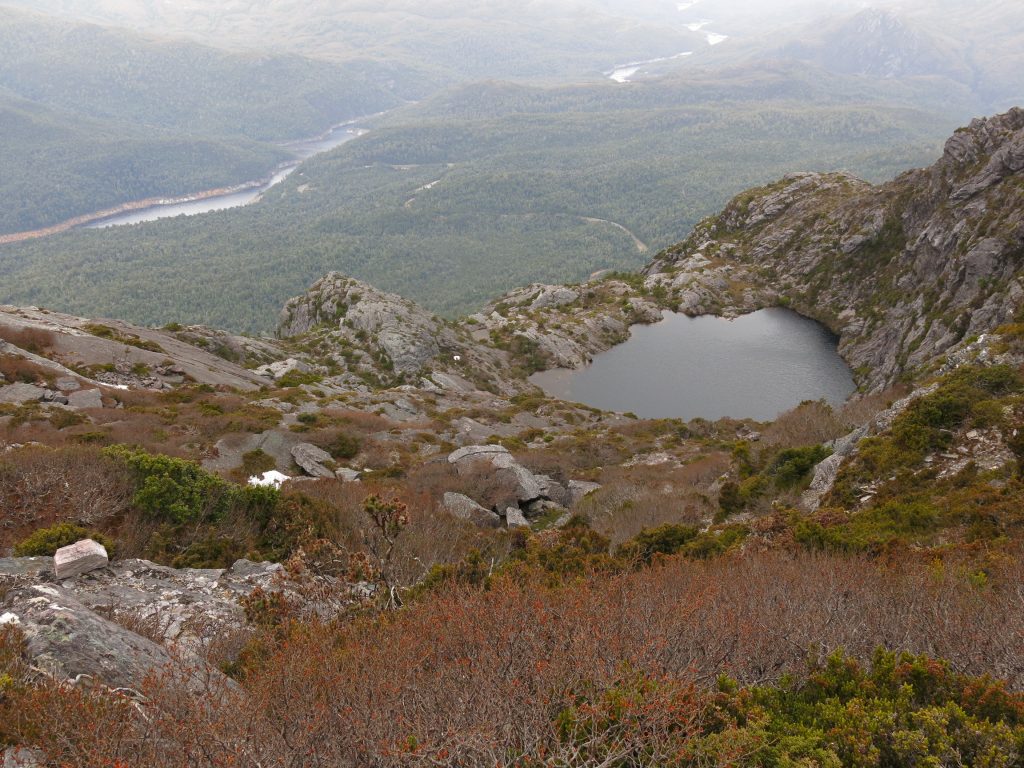


Hi Bron, loved your description of the walk. I’m leading a group from the Northern Rivers Bushwalkers Club on the Tarkine coast walk and then in the Tarkine forest and we thought we would do Mt Murchison in between. We would like to do this loop but we have 2 members who are not keen on exposure. Those photos of you in the red jacket and yellow beanie seem to show some serious sphincter tightening exposure on that knife edge. Does it go on for long? Should we forget about doing it?
Hi Stephen, the knife edge section is certainly exposed, but only for about 5-10m. The remainder of the walk is not particularly exposed. It’s an amazing walk, but your decision would probably depend on a combination of weather and the level of your group members aversion to exposure. It wouldn’t be an enjoyable walk in poor visibility or strong gusty winds. As for level of exposure – everyone is different, so it is hard to say. I don’t generally mind heights but I have a strong dislike of dodgey traverses that feel exposed when canyoning or scrambling, and at times need someone nearby for moral support. This one I thought was great fun and happily went on ahead- I think perhaps even laughing as I went and calling back to T2 about how great it was. I couldn’t give advice on whether or not you should do it, as I do not know your group. Stepping out of your comfort zone is one thing, but massively exceeding it is another thing entirely. The exposed section is short though, and could be easily crawled/shuffled with a leg either side if needed – and having someone calm right behind for support can really help too.
Enjoy your trip, whatever you choose. It’s a lovely area!
We loved this hike as well! We had no idea about Lake Sandra though, we will have to come back one day. I loved reading this post, and the photos are great!
Hello everyone and or anyone who could tell me roughly how much time this circuit would generally take as I’d like to give it a nudge this weekend?
Just from pole D15 via lake Sandra/Mt Mercherison and down to pole D55?
And not the time walking along the road back to our car as its not so important. Cheers Ronnie
I don’t have exact times, but I think it took us at least seven hours. We lost a little time having a swim and exploring around, but I’d give yourself a full day.
Thanks matey, much appreciated ✌️😉
Did the walk on Saturday last. Start to finish was 7hrs30mins including lunch and summit stops. I was the slowest in the group with the fastest finishing in a shade over 7hrs. We went off our planned route a couple of times which added to the fun. We started at D55 and ended at D15.
Mt Murchison- what an ordeal. My partner and I got completely lost at about the half way point on the way back down. The climb up was beautiful and at times quite tough for a couple in their mid 70’s but once on top of the summit it all felt reasonably easy. We were in the middle of a strong 5 day high in May, so there were no weather issues to scare us. The base of the mountain was surrounded in fog and cloud at all times but the higher levels were sunny and very clear at all times.
Heading back down from the summit we passed all the tricky bits quite easily but when we actually got to the middle of the track where it is flatter and very open we got lost. I noticed one of the usual orange pointed track markers lying in the centre of the track in an unusual position but seeing no other track to follow we continued on thinking we would hit a pile of rocks lying across the track if we were going the wrong way. There were none so we continued on following a normal looking track heading slowly downwards. After about 20 minutes the track began to dissolve and disappear.
What to do. The road was very often visible way down below us and tantalising so we decided to just head for it following a slippery and steep creek bed. It was hard going but we were making progress until something I was hanging on to gave way and I slipped into water up to my knees. So did my partner as the wet moss was treacherous. We continued on but finally came to a cliff with extremely dense bush, almost impenetrable on either side.
I think at this point we had decided that we had made a big mistake and started contemplating the thought of having to retrace our steps and head back upwards.
As we had about 50 minutes of light left we went as fast as possible to try and get up above the fog and cloud line as we knew we were in for a very cold night. As it got dark I looked for a place to possibly sleep but the terrain was too vertical so sitting on top of a bush was the only possibility. With wet feet and wet fingers from torn gloves we knew we were not going to be able to do anything more than stand up all night and exercise to keep warm. We found the only rock shelf available. It was about 1500mm by 500mm
so tiny and very dangerous with a vertical downward rock face behind us and very thick vegetation in front of us. I stripped the vegetation off two tiny trees immediately in front of us and we used their trunks like springy walking sticks to keep our shoulders moving and at least exercised. It was necessary to keep our feet and toes moving at all times. As it soon became pitch black we settled into 14 hours of continual movement. Around midnight a very welcome moon appeared on the horizon cheering us up. We both had very good mountain clothing and boots for a day walk but would have obviously rugged up more if we had known we were going to get into trouble. The temperature hovered around 0 degrees.
Finally dawn slowly emerged but the fog had followed us up the hill so it was 7am before we could see enough to move on upwards. We knew the only mobile signal was on the other side of Mt Murchison as it is provided for the mines and so our only thought was bush bashing back to the summit ridge line to call for help. We were also hoping to find the correct Mt Murchison track but it never reappeared.
Once out in glorious sunshine we kept on scrambling upwards but it was very hard going without a track and often extremely dangerous. We were however extremely determined and so we helped each other climb steadily upwards. Eventually we made it to the top of the mountain but we had no idea of exactly where we were on the mountain although we could always see the peaks of Mt Roland and Frenchman’s Cap in the distance. The trouble was as we couldn’t see the metal trig station on the summit we didn’t know which way to go should we try and walk out of there.
We made it out onto a flat rocky shelf and called 000 with the two bars available. We supplied coordinates from our compass iPhones and a description of the clothing we were wearing. The Westpac Police Rescue helicopter from Hobart arrived 2 hours later. They were brilliant and being unable to land hovered at the cliff edge. We great fully jumped onboard but at that point we also realised just how spent and exhausted we really were.
The pilot advised us that they would need to fly us to Strahan because of the cloud below and so we headed off to the deserted airport there. Again they very kindly arranged for the local Police to come and pick us up and drive us
back to our car at the start on the climb.
I drove us back to our accommodation but I was cramping up rather badly. My very fit wife was in better shape with no real issues.
After a very welcome very hot shower at the Tullah Lakeview Lodge and a great meal we fell into a deep sleep in a very warm bed.
If only Parks could update those track markers – surely a simple enough thing and it will save future problems. The local Police are well aware of the problem and have reported it to Parks but nothing has happened apparently. I’m on to Jacquie Petrusma – the Ministers office – to see what can be done but so far no real progress other than that they have promised to take this up with Parks in detail. Hopefully we will hear more.
Kraig, thanks so much for sharing that experience. It sounds like quite an ordeal. Great to hear you were both unharmed.
Your account really highlights the importance of always having the ability to navigate when attempting walks. There’s lots of good apps available these days that allow you to download relevant topographic maps onto your phone (ensuring they are available without reception). An old fashioned map and compass are even more foolproof (no flat batteries). Knowing where the track goes helps ensure you don’t end up heading down false trails (which are always more visible because people walk them twice — once down and once back when they realise their error).
Relying on track markers and cairns is a recipe for disaster, especially on more remote walks. Places like Mt Murchison aren’t tourist tracks, nor should they be.
While it might be easier to dumb down remote places to make them easier for us, the better goal is to skill ourselves up so we’re able to safely visit wild places without the need to modify them. Humans have already carved roads and tracks across most of the world’s surface. It’s wonderful that some areas remain close to pristine. I’d encourage you to take this experience as a great lesson to find out what bush skills you need to develop then take the time to do so. Otherwise, you might not be so lucky next time.